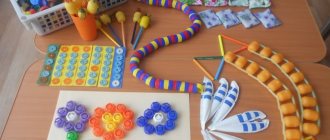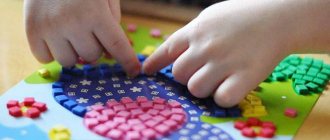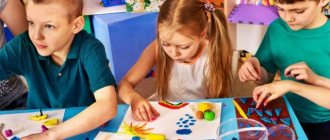Almost all parents know about the need to develop fine motor skills in children.
It stimulates the speech center, thinking and attention, helps the child prepare for school, and simplifies the development of writing. In order to help your son or daughter, it is not at all necessary to purchase expensive teaching aids or spend a lot of time on special training. A little attention, a good mood - and little fingers will gradually become skillful and dexterous, speech development will improve and new skills will appear.
Classes for children 2-3 years old
They say that everything new is well forgotten old. For the development of fine motor skills in children, the simplest games that have been played with children for centuries are ideal:
- "Magpie-crow." Take the child’s finger in your hand and move it along the palm of his other hand, telling the famous little rhyme. Then bend his fingers - “I gave to this, I gave to this.” In this way, a light massage of the nerve endings in the palm is performed and coordination of movements of individual fingers is developed. Teach your child to play magpie on his own.
- “Finger, finger, where have you been?” This game is built on the same principles. It is very important that the child learns to bend his fingers one at a time, regardless of the others.
- For massage, speech therapists often use special balls with plastic “spine” protrusions or spiral elastic bands. And you take ordinary cones. Show your child how to roll it between your palms, spin it, toss it and catch it. This is how you can not only play while walking, but also talk about nature, learn how pine and spruce cones differ, and also stimulate fine motor skills.
- Let's play Cinderella? Let your child sort through the beans - for example, offer to select the white ones from the red ones. At the same time, tell me a fairy tale.
Architectural modeling
Architectural modeling is an exercise that simultaneously uses motor, visual and associative memory. It develops the technique of mastering drawing tools, graphic literacy, instills skills in orientation in space and on a sheet of paper, and helps children in solving design problems.
For home use, you can purchase kits with ready-made models and a list of various architectural details that children will turn into a building model.
There are different types of constructors:
- sets with blocks-cubes;
- paper constructors;
- designer constructors;
- architectural designers (for those who are especially enthusiastic).
Another way to get acquainted with architectural modeling is through drawing sets, which usually include special sheets, grids, rapidographs and other necessary attributes for the future architect/designer. They are most often bought in hobby hypermarkets and art markets. Reading books, watching movies and topical lectures will also help your child become more familiar with the topic.
What can you play?
- At this age, creativity occupies a large place in children's activities. Drawing with paints, pencils and crayons, modeling, designing - all these activities not only stimulate imagination, spatial thinking and attention, but also develop hand motor skills. If your child loves creative activities, that’s great; if not, try to captivate him yourself and come up with interesting tasks. For example, drawing with blots, cotton swabs, shading, coloring three-dimensional toys, creating cards as gifts for family members.
- Shadow theater is a great idea for children's entertainment and development. Remember your childhood and show your child how to fold your palms to make a cockerel, a dog, a hare, etc. Come up with a fairy tale about them together. Here's a great activity for speech development.
- Playing in the sandbox is by no means the exclusive prerogative of children. At 4-5 years old, children can already do much more than just make Easter cake. Organize the construction of a real castle in your yard with a moat, roads, decorations and more. Precise and coordinated finger actions perfectly stimulate motor skills. A walk will be beneficial not only for health, but also for development.
- Summer is over and it's winter outside? This does not mean that there is nowhere to study. Get ready for the New Year together! Wrapping nuts in foil, rolling pieces of cotton wool into “snow” balls, wrapping gifts - all this is a great opportunity to develop fine motor skills and create a joyful pre-holiday mood. Cut out snowflakes together, draw on the windows with toothpaste - these activities will bring great joy to your child, and you will be pleased with the development of your treasure.
Pay attention to the development of logical and creative thinking in children, as well as the development of phonemic awareness.
Drawing for children
Almost all children love to draw, so they will like such exercises. Finger paints are perfect for preschool children - this type of creativity uses both hands at once, which has a great effect on brain development.
Schoolchildren can already be offered exercises with a pencil. Activities such as tracing flat shapes, drawing using reference points, completing the missing half of a picture, or drawing according to a model without taking your hands off the paper are perfect for this age.
The main thing is to avoid monotony and come up with entertaining stories for each task. For example, you can prepare special cards where the images will have no outline, and the child will have to restore this outline. Labyrinths are also excellent for developing motor skills, which the child must “go through” in one line, without going beyond the outline.
Classes for children 6-7 years old
Your child will soon go to school. But you shouldn’t rely only on training courses for preschoolers. There the child will be taught letters and counting, but the main thing is a solid foundation. Fine motor skills training reaches a new level:
- It's time to involve your son or daughter in helping around the house. For children, you can get a special knife that they could not get hurt with, and let them participate with their mother in cooking. Cutting boiled vegetables is not difficult, but in this way your fingers will become more skillful, and the necessary skills will be instilled by themselves.
- Dad can show you how to use a screwdriver. Tightening screws and screws will also benefit motor skills. The child can be asked to choose the necessary nails, nuts and other small parts from the box.
- Teach children to weave wreaths, braids for dolls, make beads and other decorations.
- A good activity that develops logic and is useful for developing finger coordination is laying out figures from matches, solving problems with counting sticks.
We have offered the simplest activities that will help stimulate the development of fine motor skills in a child in basic living conditions. As they say, without leaving household chores. However, undoubtedly, many families also have special toys and aids for children's development. Don't underestimate them. Depending on the child's age, use:
- All kinds of mosaics and puzzles. For kids, choose sets with large parts; as they master them, purchase smaller and more complex ones.
- Sorters, pyramids, inserts and frames.
- Kits for creativity, making jewelry and crafts.
- Books with stickers.
- Various board games aimed at controlling hand movements. For example, the game “Jenga” and its more childish version “Jolly Hippopotamus” are very popular, in which you need to carefully pull out sticks or blocks so as not to drop the constructed structure. By the way, adults will also enjoy playing Jenga.
Involve your children in your activities and find time to play together. Good family relationships and an intelligent, developed child will be your reward.
Publication date: 11/15/2016. Last modified: 05/09/2018.
Development of fine motor skills in children
Many parents know about the importance of developing fine motor skills in children.
Indeed, this is a very important aspect in the development of a child. The development of speech, coordination skills, dexterity, and intelligence depend precisely on how well the fine motor skills of the fingers are developed. The fact is that the brain centers responsible for speech and finger movement are located close and as one develops, the other also develops.
How to develop fine motor skills in children, what games and exercises are there? I have prepared a sample list for you. Try it with your baby and see how he copes with it. Not everything can be achieved at once; for some games and tasks it is necessary to develop a skill. During the exercises, dexterity and precision of movements are trained. If at 5-6 years old tasks are difficult to complete and the child avoids such games and tasks, then I recommend coming for a consultation with a speech therapist so that children do not have problems with writing at school. The inability to perform precise movements in children of this age may indicate disorders that require diagnosis and correction.
From 1 year to 3 years
- massage of fingers, palms and self-massage, including a needle ball (su-jok), massage of the hands with a hair brush;
- massage the fingertips with a clothespin + attach clothespins to a rope, onto a sheet of paper;
- draw with your fingers in the sand;
- massage in cereals with sea salt (pour the cereal and salt into a container) + remove small objects from the cereal and try to identify the object by touch;
- sort through cereals (peas, beans, buckwheat, rice); place the cereal into different jars with both hands;
- finger games (goat-cow, rings, chains, fan, house, palms, etc.) and shadow theater;
- turning the pages of a book;
- finger small beads;
- collect small objects one by one in a handful;
- screw in, tighten caps, nuts;
- build towers from cubes, collect pyramids.
From 3 years to 4-5 years
- modeling from plasticine;
- stretch the rubber band with the fingers of one hand;
- drawing with stencils;
- collect large and small mosaics and puzzles;
- string beads onto a string (thread);
- games with construction sets (Lego, etc.), assembling construction sets according to diagrams;
- tear paper into small pieces;
- roll plasticine balls with one hand;
- snapping fingers;
- fasten, unfasten buttons;
- tie, untie knots (you can “weave” beads and buttons into the knots).
From 4-5 years
- drawing on dots, dotted lines;
- assembling construction sets with small parts (Lego, metal construction sets);
- shading, carefully coloring figures with colored pencils;
- lace shoes, including according to patterns;
- lay out figures, letters, numbers, a well of matches, small sticks;
- cut out shapes from paper, cut along the marked lines;
- applique;
- draw with chalk (on a blackboard, asphalt), walk paths with paints along given “routes”,
- decorate with paints;
- embroidery on canvas;
- sewing on buttons;
- roll the pencil between the fingers of one hand;
- origami according to schemes.
Graphic dictations
They perfectly develop not only fine motor skills, but also perseverance. The adult must prepare in advance a picture that the child will draw on a checkered sheet of paper (you can get inspiration and find examples on Pinterest).
There are two options for graphic dictations:
- First (and simplest). You need to show your child a sample of a geometric pattern and ask him to repeat it. To do this, you only need a squared notebook and a pencil with an eraser so that you can correct any bad lines.
- Second. Dictate to your child the number of cells and the direction of the drawing (for example, in this format: two cells to the right/three cells up/one cell to the right). This is how the child learns to be attentive and listens to what you say. If you perform the exercise correctly, you will get a picture on the sheet. You can check it by superimposing the resulting drawing on the original.
Advertising
Origami and polygonal modeling
Making paper products is a rather labor-intensive and responsible activity that requires good coordination and perseverance, so these exercises are suitable for children whose fine motor skills are already sufficiently developed. The result is worth it!
To prepare your child for creating complex shapes, you need to start giving him the simplest tasks in advance: carefully folding a sheet of paper in half, folding corners, assembling paper airplanes. By the age of 6-7 years, the child will have already learned to handle paper carefully, and it will be possible to move on to the next stage.
Origami is suitable for beginners, but polygonal paper modeling can be difficult even for adults. Now on the Internet you can find a huge number of training videos and articles with drills for any level of training. The easiest way is to look for instructions and detailed scans on YouTube or Pinterest.
How and from what to sculpt with a child
Modeling from plasticine, clay or special dough is an excellent exercise for fine motor skills, as well as a good anti-stress for parents. It doesn’t matter at all what the child will sculpt, the main thing is to use the whole palm. To begin with, you can sculpt the simplest shapes: balls and sausages. Then you can complicate the task and reduce the size of the finished products: the smaller the figures that the child sculpts, the more effectively his fine motor skills develop.
If you don't have plasticine or clay on hand, you can always make your own play dough. To do this you will need flour, water, sunflower oil, salt, food coloring or watercolor. For a glass of flour you need to take a glass of salt, ⅔ glass of water and 1 tbsp. oils, coloring can be added as desired. Mix all ingredients, add more water if necessary. This dough can be stored for a long time in the refrigerator in a plastic bag.
What are fine motor skills?
Fine motor skills are the ability to coordinate the movements of the small muscles of the wrist, palms, fingers, and even toes. General motor skills are the ability to coordinate the movements of large muscles of the arms, legs and feet, as well as the ability to control the entire body. How to develop hand motor skills in a child? To do this, you can perform special exercises with him and play age-appropriate games. Even the simplest exercises, such as moving a toy brick or picking up a piece of food from a plate, prepare your baby for more complex tasks, such as writing or buttoning up buttons. It must be remembered that a child’s development can proceed in different ways, and everyone develops at their own pace. Compared to other children, your baby's development of fine and gross motor skills may be either advanced or delayed, and this is normal.








